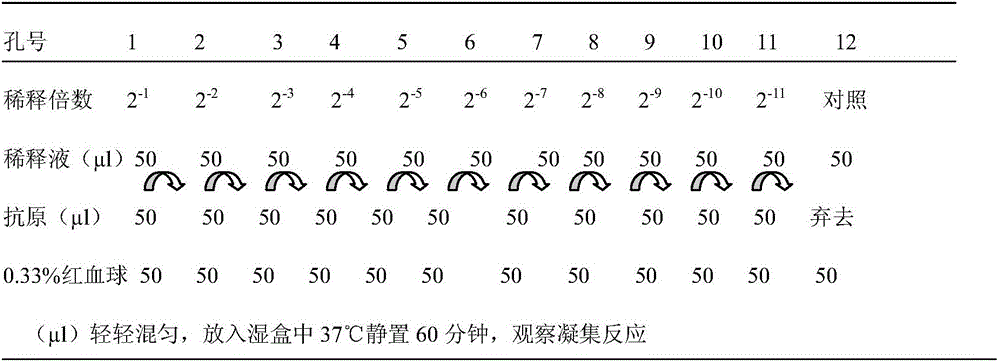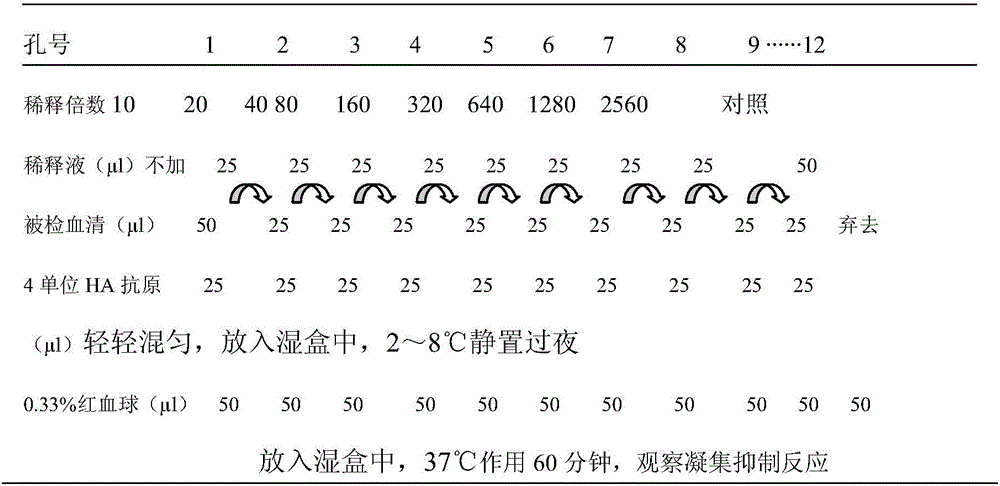Antigen for hemagglutination inhibition test of duck Tembusu virus disease and preparation method thereof
A technology for duck tembusu virus and hemagglutination inhibition test, which is applied in the fields of bioengineering and immunology, can solve the problems of unified regulations or formulation of the disease name, and no country yet, and achieves the effect of antigen stabilization.
- Summary
- Abstract
- Description
- Claims
- Application Information
AI Technical Summary
Problems solved by technology
Method used
Image
Examples
Embodiment 1
[0025] Raw materials for the preparation of antigens:
[0026] 1) Sensitive (choose 2-4 days old closed group or inbred strain) suckling mice, via intracerebral route, according to 25μl / mouse (about 100ELD 50 ) dose inoculated with duck Tembusu virus, observed to 144 hours, the suckling mice appeared clinical symptoms such as mental depression and tremor, and the suckling mice morbidity and mortality should be greater than 90%.
[0027] 2) Duck Tembusu virus, a member of the Flaviviridae family, contains a specific gene sequence, and its GenBank accession number is JF523187. The results of gene sequence analysis of the isolated strain show that the strain has the highest homology with Tembusu virus. Virus particles are 30-50nm in size, spherical, with capsules and fibrils, and can agglutinate 0.25-0.6% goose and pigeon red blood cells. The virus can be detected in closed population or inbred mouse brain, chicken embryo, duck embryo, duck embryo fibroblast, C6 / 36 (Aedes albopi...
Embodiment 2
[0045] Raw materials for the preparation of antigens:
[0046] 1) C6 / 36 cells (100TCID 50 / 0.1ml dose to inoculate the cells growing into a monolayer, and the typical CPE lesions appeared in the cells after 120 hours of observation).
[0047] 2) Duck Tembusu virus, a member of the Flaviviridae family, contains a specific gene sequence, and its GenBank accession number is JF523187. The results of gene sequence analysis of the isolated strain show that the strain has the highest homology with Tembusu virus. Virus particles are 30-50nm in size, spherical, with capsules and fibrils, and can agglutinate 0.25-0.5% goose and pigeon red blood cells. The virus can be detected in closed population or inbred mouse brain, chicken embryo, duck embryo, duck embryo fibroblast, C6 / 36 (Aedes albopictus cells), BHK21 (suckling hamster kidney cells) and Vero (African green monkey kidney cells). ) grow on the cells.
[0048] The virus mainly infects ducks, geese and chickens, etc. Ducks, geese...
Embodiment 3
[0065] On the basis of Example 1, there is further optimization, and the materials and reagents used are the same as in Example 1.
[0066] Duck Tembusu virus HB strain (F1 generation) was used as the virus seed, with 25 μl / piece (including 100ELD 50) dose of intracerebral inoculation of 2 to 4-day-old KM breed suckling mice. Take out the mice with obvious clinical symptoms such as depression and tremor in time, and store them below -20°C. The suckling mice were taken out, the brains were disinfected with tincture of iodine, the skin and skull of the brains were removed under aseptic conditions, the brain tissue was taken out, and placed in a sterilized container. Add sterile sucrose solution with a final concentration of 8.5% according to the ratio of W / V=1:4, and homogenize. Under stirring state, add the homogenate dropwise into the cold acetone of 10-30 times the volume of the homogenate. Centrifuge at 500 g for 5 min, discard the supernatant, crush the precipitate with ...
PUM
| Property | Measurement | Unit |
|---|---|---|
| diameter | aaaaa | aaaaa |
Abstract
Description
Claims
Application Information
 Login to View More
Login to View More - R&D
- Intellectual Property
- Life Sciences
- Materials
- Tech Scout
- Unparalleled Data Quality
- Higher Quality Content
- 60% Fewer Hallucinations
Browse by: Latest US Patents, China's latest patents, Technical Efficacy Thesaurus, Application Domain, Technology Topic, Popular Technical Reports.
© 2025 PatSnap. All rights reserved.Legal|Privacy policy|Modern Slavery Act Transparency Statement|Sitemap|About US| Contact US: help@patsnap.com


